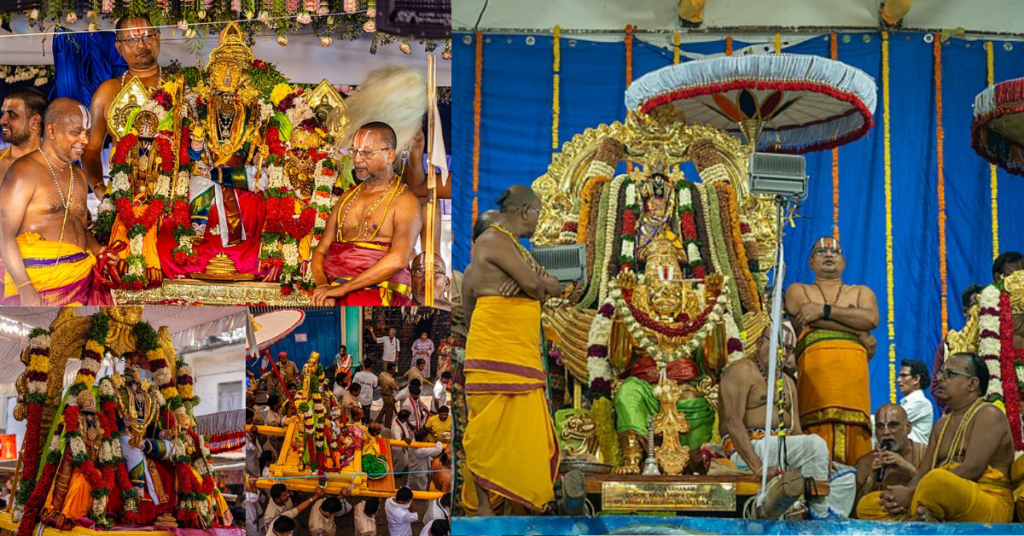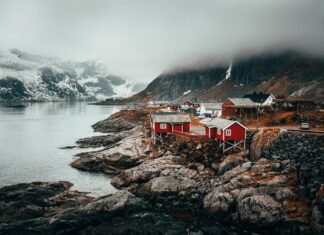Sri Sita Ramachandra Swamy Temple in Bhadrachalam, Telangana.Is more than just a place of worship. It’s a vibrant testament to the enduring devotion of a community towards Lord Rama. The temple, situated on the serene banks of the Godavari River, draws thousands of devotees each year. Who come to seek the blessings of Lord Rama and partake in the temple’s rich spiritual traditions. This blog delves deep into the temple’s storied past, architectural marvels, and religious fervor. That continues to make it one of the most important pilgrimage sites in South India.

History of Bhadrachalam Temple
In the 17th century, Bhakta Ramadasa, born Gopanna, served as a Tahsildar in the Kingdom of Golconda under the rule of Abdul Hassan Tanah Shah. Gopanna, an ardent devotee of Lord Sri Rama, was deeply committed to the worship and upkeep of the Bhadrachalam Temple. Driven by his devotion, he used government tax funds to renovate the Bhadrachalam Temple. Adorn the idols with gold and precious jewels, all without seeking permission from his superiors. This act, though done out of reverence, was considered a serious offense against the kin. Leading to his arrest and imprisonment in the Golconda Fort by the Nizam.

During his time in prison, Ramadasa composed numerous devotional poems, expressing his unwavering love for Lord Rama. His anguish over the Lord’s perceived silence in the face of his suffering. Miraculously, Lord Rama appeared in a dream to Tanah Shah. Returned the exact amount that Ramadasa had spent on the temple. This miraculous event led to Gopanna’s release from prison. He continued his service to the temple with even greater zeal.
Also Read: Exploring Khammam Fort a Timeless Treasure of Telangana
Special Status by the Nizam
The Nizam of Hyderabad, impressed by the devotion and miraculous events surrounding the temple, granted it a special status. The temple was henceforth regarded with great reverence, not only by the local people but also by rulers and devotees from various parts of India.
Mythological Connection to the Ramayana
The Bhadrachalam Temple is deeply connected to the Ramayana, an ancient Indian epic. According to legend, during the Treta Yuga, Lord Vishnu’s avatar, Rama, spent part of his 14-year exile in the Dandaka Forest with his wife Sita and brother Lakshmana. One day, Rama’s touch turned a stone into a human named Bhadra. Who was believed to be the son of Mount Meru. Bhadra was a devoted follower of Rama and met the sage Narada, who taught him the Rama Taraka Mantra. Bhadra chanted this mantra on the banks of the Godavari River. Meditated for many years, hoping to meet Rama again.

Pleased with Bhadra’s devotion, Rama promised to meet him after rescuing Sita from the demon king Ravana. Although Rama couldn’t fulfill this promise during his lifetime, Lord Vishnu appeared before Bhadra in the form of Rama. However, Vishnu appeared in his divine form with four arms instead of Rama’s two-armed mortal form. In this vision, Sita sat on his left thigh, and Lakshmana stood to his left.
Another local legend tells the story of a tribal woman named Pokala Dhammakka, who lived in Bhadrareddypalem. She is said to be a descendant of Sabari, a devoted follower of Rama. One night, Dhammakka had a dream that led her to discover an idol of Rama hidden inside an anthill. She dissolved the anthill using water from the Godavari River. With the help of the villagers, built a small temple (mandapam) to worship the deity.
Architecture and Design of Bhadrachalam Temple

The Sri Seetha Ramachandra Swamy Vari Temple is intricately designed to symbolize different parts of the mythological figure Bhadra, With the temple’s layout reflecting Bhadra’s head, heart, and feet. The temple’s main sanctum, located at Bhadra’s heart, houses the central icon, believed to be Swayambhu (self-manifested). The temple also features a majestic Rajagopuram tower. Representing Bhadra’s feet, and is adorned with a gold-plated flag post, or Dwajasthambam, made from Panchaloha (a five-metal alloy). Various shrines within the temple complex are dedicated to other deities, including Hanuman, Yogananda Narasimha, and Govindaraja Swamy.
A significant part of the temple’s tradition includes the Nithyakalyana Mandapam. Where the marriage ceremony of Rama and Sita is performed. The temple also houses an exhibition center called the Rushya Mookham. Showcasing historical artifacts like coins bearing Lord Rama’s image and jewelry made by Gopanna for the deities. This temple, with its rich mythology and deep connection to the Ramayana, remains a significant spiritual and cultural landmark.

Festivals at Bhadrachalam Temple
Bhadrachalam Temple hosts several significant festivals throughout the year.

- Vaikuntha Ekadashi is a grand 21-day celebration, culminating in the main event where devotees seek blessings for salvation. This festival features a float festival, Teppotsavam, and a chariot procession, Rathotsavam, which coincides with Makar Sankranti.
- Vasanthotsavam, the spring festival coinciding with Holi, marks the start of preparations for Brahmotsavam. It includes the creation of Mutyala Talambralu, which is used in marriage rituals, and the Maha Kumbhaprokshana, a sanctification ceremony followed by Holi celebrations.
- Brahmotsavam is the temple’s most important annual festival, celebrated over 12 days, including Rama Navami, the birthday of Rama, and the Thirukalyana Mahotsavam, the marriage ceremony of Rama and Sita. The festival involves elaborate rituals such as Visesha Snapanam, Garudadhivasam, Dwajarohanam, and the coronation ceremony Mahapattabishekam.
- Vijayadashami festival, marking the end of the ten-day Dussehra, features the recitation of the Ramayana and a grand procession of Rama. Other notable festivals include Sabri Smruti Yatra, Hanuman Jayanti, Dhamakka Seva Yatra, and Jayanthi Utsavam, celebrating the birthdays of Gopanna and Narasimha Dasu.
Also Read: The Exclusive Mystical Beauty of Papi Kondalu (Papi Hills)
Religious Significance OF Bhadrachalam

Sri Sitaramachandra Swamy Temple holds immense significance in Vaishnavism, a major Hindu tradition that worships Lord Vishnu and his avatars, including Lord Rama. The temple is believed to be a powerful spiritual center, where devotees can connect with the divine and seek liberation (moksha). The temple’s association with the epic Ramayana, particularly Lord Rama’s journey, makes it a key pilgrimage site, especially for those devoted to the Ramayana’s teachings.
BhadrachalamTemple Timings and Rituals
The temple is open to devotees from 4:30 AM to 1:00 PM and from 3:00 PM to 9:00 PM daily.
| S.No | Seva description | Time |
| 1 | Antaralaya Abhishekam (Mulavarulu on Sundays) | 6.00 AM to 7.00 A.M |
| 2 | Abhishekam (at Bhadra Temple) Daily | 7.00 AM to 8.00 A.M |
| 3 | Kesavanaamaarchana | 8.30 A.M to 8.00 P.M |
| 4 | Sahasranamarchana | 8.30 A.M to 9.30 A.M |
| 5 | Suvarna Tulasi Astotharanamarchana (on every Saturday) | 8.30 A.M to 9.30 A.M |
| 6 | Suvarna Pushpa Astothara Namarchana (Every Sunday) | 8.30 A.M to 9.30 A.M |
| 7 | Sakalbhishtaprada Sree Ramapuja (daily) | 8.30 AM |
| 8 | Nitya Kalyana Ubhayam (Daily, except during Pavitrotsavams, Brahmotsavams, and Vykunta Ekadasi) | 9.30 A.M to 11.00 A.M |
| 9 | Rajata Ratha Seva | From 6.30 PM |
| 10 | Alaya Chuttu Seva | 8.00 PM to 8.30 P.M |
| 11 | Vahana Seva (Garuda, Hamsa, Hanumantha, Rajadhiraja) | 8.00 PM to 8.30 P.M |
Visiting Places near Bhadrachalam Temple
Parnashala

Parnashala is a site of immense religious and historical significance, located about 35 kilometers from Bhadrachalam. It is believed to be the exact spot where Lord Rama, during his exile (Vanavasa) in the Dandakaranya forest, constructed a hermitage and lived with his wife, Sita, and brother, Lakshmana. The sage Agastya is said to have selected this serene location for Rama’s stay.
The site offers a picturesque display of scenes from the Ramayana, particularly those depicting the Vanavasa period. Visitors can see the footprints of Sita Devi, the mosaic representation of Maarecha in the guise of the golden deer, and Ravana in the guise of a Sanyasi seeking alms (Bhikshatana). Nearby, there is Sita Vaagu, where Sita is said to have bathed and collected turmeric and kumkum from the surrounding stones. The rocks in this area still bear the marks of her saree. The deity worshipped here is known as Sokarama, named after the sorrowful events surrounding Sita’s abduction by Ravana. The tracks of Ravana’s chariot used to kidnap Sita, can also be seen on the mountain across the river bank near the Parnashala temple.
Also Read: Gundala Waterfalls: An Exclusive Hidden Gem in Telangana
Jattayu Paaka (Yetapaka)

Located just 2 kilometers from Bhadrachalam, Jattayu Paaka, or Yetapaka, is another site deeply intertwined with the Ramayana. According to the epic, this is where the valiant bird Jatayu, a devotee of Lord Rama, attempted to stop Ravana as he was abducting Sita in his chariot. Despite his bravery, Jatayu was mortally wounded in the battle with Ravana. The bird awaited the arrival of Lord Rama at this spot before succumbing to his injuries. It is believed that one of Jatayu’s wings fell at Rekkapalli, about 55 kilometers away, in V.R. Puram Mandal.
Dummugudem

Dummugudem is a village named after an event in the Ramayana where Lord Rama defeated 14,000 demons led by Khara and Dushana. The name “Dummugudem” derives from the belief that the village was built upon the ashes (dummu) of these demons. The deity worshipped here is called Atmarama, reflecting Rama’s inner strength and resolve during the battle.
Gundala
Situated 5 kilometers from Bhadrachalam, Gundala is renowned for its natural hot springs located on the riverbank. Pilgrims believe that these springs have divine origins, as per the Brahma Purana, which states that the divine trinity of Brahma, Vishnu, and Maheswara took their dips here during the winter season. The presence of these hot springs adds a mystical charm to the area, attracting visitors who wish to experience this sacred phenomenon.
Sree Rama Giri

Sree Rama Giri: Sree Rama Giri is located about 55 kilometers downstream from Bhadrachalam on the bank of the Godavari River. The site is home to the Yoga Rama Temple, where the deity is worshipped in a meditative posture, symbolizing the spiritual aspects of Lord Rama. The temple is situated on a hill, offering a serene and peaceful atmosphere for devotees and visitors alike. The location, surrounded by natural beauty, is a tranquil spot for those seeking spiritual solace and connection with Lord Rama.
Accommodation and Facilities
Excellent lodging options include Government Guest Houses,Telangana Tourism Hotels, Cottages, and Sadanams in Bhadrachalam. Additionally, some private hotels and lodges offer lodging.
Visit the below Links for Temple Accommodation enquiry and booking
https://www.bhadrachalarama.org/
https://bhadradritemple.telangana.gov.in/
Conclusion
The Sri Sitaramachandra Swamy Temple in Bhadrachalam is not just a place of worship; it is a beacon of faith, history, and cultural heritage. The temple’s rich history, associated with Bhakta Ramadasu, its architectural grandeur, and the spiritual ambiance make it one of the most important pilgrimage sites in South India. Whether you are a devotee or a tourist, a visit to this temple is a journey into the heart of devotion and a glimpse into the rich spiritual traditions of India.
Frequently Asked Questions(FAQs)
A: The temple is dedicated to Lord Rama.
A: The temple was built by Kancharla Gopanna, also known as Bhakta Ramadasu.
A: He renovated the temple using tax funds and was later released from imprisonment due to divine intervention.
A: The temple is open from 4:30 AM to 1:00 PM and 3:00 PM to 9:00 PM every day.
A: The temple is known for its annual chariot festival, a major event in the region.











